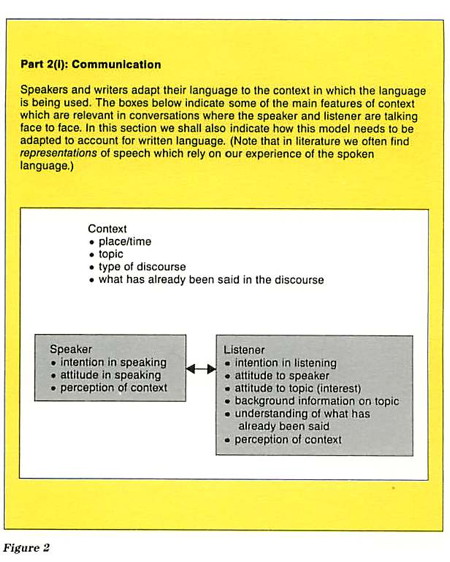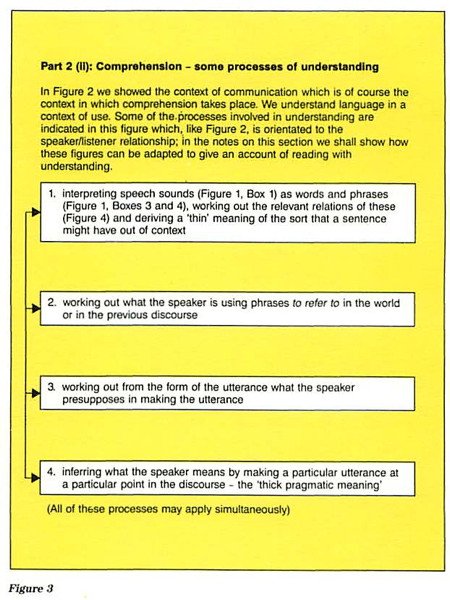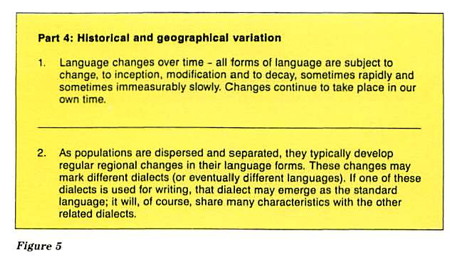[page 93]
Appendix 7 Bibliography to supplement Chapter 3
We begin by proposing some books with very wide coverage as an orientation to the study of language. (In all cases, date of publication refers to the most recent edition.)
Bolinger, D. L. and Sears, D. A. (1981) Aspects of language Harcourt Brace Jovanovich
Hawkins, E. (1987) Awareness of language: An introduction Cambridge University Press
Quirk, R. (1968) Use of English Longman
Yule, G. (1985) Study of language: An introduction Cambridge University Press
Figure 1: Forms of language
Figure 1 Box 1
Brazil, D., Coulthard, M. and Johns, C. (1980) Discourse, intonation and language teaching Longman
Brown, G. (1977) Listening to spoken English Longman
Crystal, D. (1975) English tone of voice: Essays in intonation, prosody and paralanguage Edward Arnold
Fudge, E. C. (1984) English word stress Allen and Unwin
Gimson, A. C. (1980) Introduction to the pronunciation of English Edward Arnold
O'Connor, J. D. (1973) Phonetics Penguin
Quirk, R. and Greenbaum, S. (1973) University grammar of English Longman
Turner, G. W. (1973) Stylistics Penguin, ch. 2
Wells, J. C. (1982) Accents of English Cambridge University Press (3 vols.)
Figure 1 Box 2
Albrow, K. H. (1972) The English writing system: Notes towards a description Schools Council: Longman
Baugh, A. C. and Cable, T. (1978) History of the English language Routledge and Kegan Paul
Diringer; D. (1962) Writing Thames and Hudson
Frith, U. (ed.) (1980) Cognitive processes in spelling Academic Press
Gelb, I. J. (1952) Study of writing University of Chicago Press
Halliday, M. A. K. (1985) Spoken and written language Deakin University Press
Jarman, C. (1979) The development of handwriting skills Blackwell
Perera, K. (1984) Children's writing and reading: Analysing classroom language Blackwell
Sampson, G. (1985) Writing systems Hutchinson
Scragg, D. G. (1975) History of English spelling Manchester University Press
Stubbs, M. (1980) Language and literacy: The sociolinguistics of reading and writing Routledge and Kegan Paul
Venezky, R. L. (1970) The structure of English orthography Mouton
Figure 1 Box 3
Adams, V. (1976) Introduction to modern English word formation Longman
Aitchison, J. (1987) Words in the mind: An introduction to the mental lexicon Blackwell
Allan, K. (1986) Linguistic meaning Routledge and Kegan Paul (2 vols.)
Bauer, L. (1983) English word-formation Cambridge University Press
Carter, R. and McCarthy, M. (1988) Vocabulary and language learning Longman
[page 94]
Cruse, D. A. (1986) Lexical semantics Cambridge University Press
Gairns, R. and Redman, S. (1986) Working with words: Guide to teaching and learning vocabulary Cambridge University Press
Hurford, J. R. and Heasley, B. (1983) Semantics: A coursebook Cambridge University Press
Ilson, R. (ed.) (1985) Dictionaries, lexicography and language learning Pergamon Press
Lakoff, G. and Johnson, M. (1980) Metaphors we live by University of Chicago Press
Leach, G. (1974) Semantics Penguin
Lyons, J. (1977) Semantics Cambridge University Press, vols.1 and 2
Matthews, P. H. (1974) Morphology: Introduction to the theory of word structure Cambridge University Press
Ortony, A. (ed.) (1979) Metaphor and thought Cambridge University Press
Palmer, F. R. (1981) Semantics: A new outline Cambridge University Press
Quirk, R. and Greenbaum, S. (1973) University grammar of English Longman
Figure 1 Box 4
Allerton, D. J. (1979) Essentials of grammatical theory: A consensus view of syntax and morphology Routledge and Kegan Paul
Crystal, D. (1988) The English language Penguin
Gannon, P. and Czerniewska, P. (1980) Using linguistics: An educational focus Edward Arnold
Leech, G. (1982) English grammar for today: New introduction Macmillan
Leech, G. N. (1972) Meaning and the English verb Longman
Leech, G. N. and Svartvik, J. (1975) Communicative grammar of English Longman
Palmer, F. (1988 forthcoming) The English verb Longman
Perera, K. (1984) Children's writing and reading: Analysing classroom language Blackwell, ch. 2
Quirk, R. and Greenbaum, S. (1973) University grammar of English Longman
Winter, E. (1982) Towards a contextual grammar of English Allen and Unwin
Young, D. J. (1984) Introducing English grammar Hutchinson Education
Figure 1 Box 5
Allan, K. (1986) Linguistic meaning Routledge and Kegan Paul (2 vols.)
Brown, G. and Yule, G. (1983) Discourse analysis Cambridge University Press
De Beaugrande, R. A. and Dressler, W. U. (1981) Introduction to text linguistics Longman
Goffman, E. (1981) Forms of talk Blackwell
Gumperz, J. J. (1982) Discourse strategies Cambridge University Press
Halliday, M. A. K. and Hasan, R. (1976) Cohesion in English Longman
Hoey, M. (1983) On the surface of discourse Allen and Unwin
Levinson, S. C. (1983) Pragmatics Cambridge University Press
Quirk, R. (1987) Words at work: Lectures on textual structure Longman
Quirk, R. and Greenbaum, S. (1973) University grammar of English Longman
Stubbs, M. (1983) Discourse analysis: The sociolinguistic analysis of natural language Blackwell
van Dijk, Teun A. (1980) Text and context: Explorations in the semantics and pragmatics of discourse Longman
Widdowson, H. G. (1983) Learning purpose and language use Oxford University Press
[page 95]
Figures 2 and 3: Communication and comprehension
Figure 2: Communication
Brown, P. and Levinson, S. C. (1987) Politeness Cambridge University Press
Bygate, M. (1987) Speaking Oxford University Press
Grice, P. (1975) 'Logic and conversation' in P. Cole and J. L. Morgan (eds.) Syntax and semantics vol.3: Speech acts Academic Press
Gumperz, J. J. (1982) Discourse strategies Cambridge University Press
Hudson, R. A. (1980) Sociolinguistics Cambridge University Press
Kress, G. (1982) Learning to write Routledge and Kegan Paul
Lyons, J. (1981) Language, meaning and context Fontana
Milroy, J. and Milroy, L. (1985) Authority in language: Investigating language standardisation and prescription Routledge and Kegan Paul
Montgomery, M. (1985) Introduction to language and society Methuen
O'Donnell. W. R. and Todd, L. (1980) Variety in contemporary English Allen and Unwin
Ong, W. J. (1982) Orality and literacy Methuen
Richards, J. C. and Schmidt, R. W. (eds.) (1983) Language and communication Longman
Saville-Troike, M. (1982) Ethnography of communication Blackwell
Shaughnessy, M. (1977) Errors and expectations Oxford University Press
Sinclair, J. McH. and Brazil, D. (1982) Teacher talk Oxford University Press
Smith, F. (1982) Writing and the writer Heinemann
Wardhaugh, R. (1985) How conversation works Blackwell
Widdowson, H. G. (1978) Teaching language as communication Oxford University Press
Figure 3: Comprehension
Aitchison, J. (1976) Articulate mammal: Introduction to psycholinguistics Hutchinson Education
Allan, K. (1986) Linguistic meaning Routledge and Kegan Paul (2 vols.)
Anderson, A. and Lynch, A. (1988 forthcoming) Listening Oxford University Press
Brown, G. and Yule, G. (1983) Discourse analysis Cambridge University Press
Carter, R. (ed.) (1982) Language and literature: An introductory reader in stylistics Allen and Unwin
Clark, H. H. and Clark, E. V. (1977) Psychology and language: Introduction to psycholinguistics Harcourt Brace Jovanovich
Cluysenaar, A. A. A. (1976) Introduction to literary stylistics Batsford
Edwards, D. and Mercer, N. (1987) Common knowledge: The development of understanding in the classroom Methuen
Garnham, A. (1985) Psycholinguistics Methuen
Harrison, C. (1980) Readability in the classroom Cambridge University Press
Leech, G. N. and Short, M. H. (1981) Style in fiction: A linguistic introduction to English fictional prose Longman
Levinson, S. C. (1983) Pragmatics Cambridge University Press
Lunzer, E. and Gardner, K. The effective use of reading Heinemann Educational
Sanford, A. J. and Garrod, S. C. (1981) Understanding written language: Exploration of comprehension beyond the sentence John Wiley
Sperber, D. and Wilson, D. (1986) Relevance: Communication and cognition Blackwell
Strickland, G. (1981) Structuralism or criticisms: Thoughts on how we read Cambridge University Press
Stubbs, M. (1983) Discourse analysis: The sociolinguistic analysis of natural language Blackwell
Widdowson, H. G. (1975) Stylistics and the teaching of literature Longman
[page 96]
Figure 4: Language acquisition and development
Aitchison, J. (1976) Articulate mammal: Introduction to psycholinguistics Hutchinson Education
Brice-Heath, S. (1983) Ways with words: Language, life and work in communities and classrooms Cambridge University Press
Brown, R. (1974) First language: Early stages Allen and Unwin
Bruner, J. S. (1975) 'Language as an instrument of thought' in Davies, A. (ed.) Problems of language and learning Heinemann Educational
Clark, H. H. and Clark, E. V. (1977) Psychology and language: Introduction to psycholinguistics Harcourt Brace Jovanovich
Dale, P. S. (1976) Language development: Structure and function Holt, Rinehart and Winston
Davies, A. (ed.) (1977) Language and learning in early childhood Heinemann Educational
Donaldson, M. (1984) Children's minds Fontana
Donaldson, Morag (1986) Children's explanations: A psycholinguistic study Cambridge University Press
Durkin, K. (1986) Language development in the school years Croom Helm
Edwards, J. R. (1979) Language and disadvantage Edward Arnold
Fletcher, P. J. and Garman, M. (eds.) (1979) Language acquisition: Studies in first language development Cambridge University Press
Gordon, J. (1981) Verbal defect: A critique Croom Helm
Halliday, M. A. K. (1975) Learning how to mean Edward Arnold
Luria, A. R. and Yudovich, F. Ia. (1978) Speech and the development of mental processes in the child Penguin
Olson, D. R., Torrance, N. and Hildyard, A. (1985) Literacy, language and learning: The nature and consequences of reading and writing Cambridge University Press
Perera, K. (1984) Children's writing and reading: Analysing classroom language Blackwell
Rogers, S. (ed.) (1976) They don't speak our language: Essays on the language world of children and adolescents Edward Arnold
Romaine, S. (1984) Language of children and adolescents: The acquisition of communicative competence Blackwell
Tizard, B. and Hughes, M. (1984) Young children learning: Talking and thinking at home and at school Fontana
Vygotsky, L. S. (1962) Thought and language Massachusetts Institute of Technology Press
Wells, G. (1985) Language Development in the pre-school years Cambridge University Press
Wells, G. (1987) The meaning makers Hodder and Stoughton
Figure 5: Geographical and historical variation
Geographical variation
Bell, R. T. (1976) Sociolinguistics: Goals, approaches and problems Batsford
Dittmar, N. (1976) Sociolinguistics: A critical survey of theory and application Edward Arnold
Edwards, V. (1979) The West Indian language issue in British schools: Challenges and responses Routledge and Kegan Paul
Hudson, R. A. (1980) Sociolinguistics Cambridge University Press
Hughes, A. and Trudgill, P. (1979) English accents and dialects Edward Arnold
Kachru, B. B. (1986) Alchemy of English Pergamon Press
Linguistic Minorities Project (1983) Linguistic minorities in England Heinemann Educational
Linguistic Minorities Project (1985) Other languages of England Routledge and Kegan Paul
Montgomery, M. (1985) Introduction to language and society Methuen
[page 97]
Quirk, R. and Widdowson, H. G. (eds.) (1985) English in the world: Teaching and learning the language and literature Cambridge University Press
Rosen, H. and Burgess, T. (1980) Languages and dialects in London schoolchildren: An investigation Ward Lock Educational
Suttcliffe, D. (1983) British Black English Blackwell
Suttcliffe, D. and Wong, A. (eds.) (1986) Language of the Black experience Blackwell
Trudgill, P. (1975) Accent, dialect and the school Edward Arnold
Trudgill. P. (ed.) (1984) Language in the British Isles Cambridge University Press
Wakelin, M. F. (1977) English dialects: An introduction Athlone Press
Wakelin, M. F. (1985) English dialects Shire Publications
Historical variation
Aitchison, J. (1986) Language change: Progress or decay? Fontana
Baugh, A. C. and Cable, T. (1978) History of the English language Routledge and Kegan Paul
Greenbaum, S. (1984) The English language today Pergamon Press
Jenkins, C. (1980) Language links: The European family of languages Harrap
Lass, R. (1987) The shape of English: Structure and history Dent
Lockwood, W. B. (1975) Languages of the British Isles past and present Deutsch
Scragg, D. G. (1975) History of English spelling Manchester University Press
Strang, B. M. H. (1974) History of English Methuen
Tucker, S. I. (1961) English examined: Two centuries of comment on the mother-tongue Cambridge University Press
[page 99]
Appendix 8 The model in summary form
[The following diagrams were presented on a fold-out sheet attached inside the back cover.]











